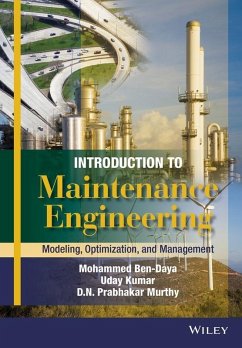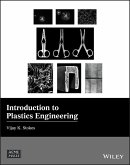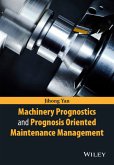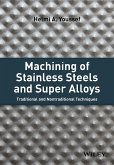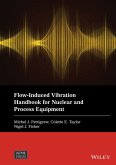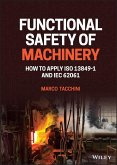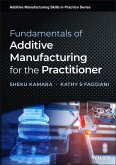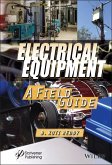Introduction to Maintenance Engineering (eBook, ePUB)
Modelling, Optimization and Management


Alle Infos zum eBook verschenken

Introduction to Maintenance Engineering (eBook, ePUB)
Modelling, Optimization and Management
- Format: ePub
- Merkliste
- Auf die Merkliste
- Bewerten Bewerten
- Teilen
- Produkt teilen
- Produkterinnerung
- Produkterinnerung

Hier können Sie sich einloggen

Bitte loggen Sie sich zunächst in Ihr Kundenkonto ein oder registrieren Sie sich bei bücher.de, um das eBook-Abo tolino select nutzen zu können.
This introductory textbook links theory with practice using real illustrative cases involving products, plants and infrastructures and exposes the student to the evolutionary trends in maintenance. * Provides an interdisciplinary approach which links, engineering, science, technology, mathematical modelling, data collection and analysis, economics and management * Blends theory with practice illustrated through examples relating to products, plants and infrastructures * Focuses on concepts, tools and techniques * Identifies the special management requirements of various engineered objects (products, plants, and infrastructures)…mehr
- Geräte: eReader
- mit Kopierschutz
- eBook Hilfe
- Größe: 27.77MB
![Introduction to Plastics Engineering (eBook, ePUB) Introduction to Plastics Engineering (eBook, ePUB)]() Vijay K. StokesIntroduction to Plastics Engineering (eBook, ePUB)152,99 €
Vijay K. StokesIntroduction to Plastics Engineering (eBook, ePUB)152,99 €![Machinery Prognostics and Prognosis Oriented Maintenance Management (eBook, ePUB) Machinery Prognostics and Prognosis Oriented Maintenance Management (eBook, ePUB)]() Jihong YanMachinery Prognostics and Prognosis Oriented Maintenance Management (eBook, ePUB)123,99 €
Jihong YanMachinery Prognostics and Prognosis Oriented Maintenance Management (eBook, ePUB)123,99 €![Machining of Stainless Steels and Super Alloys (eBook, ePUB) Machining of Stainless Steels and Super Alloys (eBook, ePUB)]() Helmi A. YoussefMachining of Stainless Steels and Super Alloys (eBook, ePUB)109,99 €
Helmi A. YoussefMachining of Stainless Steels and Super Alloys (eBook, ePUB)109,99 €![Flow-Induced Vibration Handbook for Nuclear and Process Equipment (eBook, ePUB) Flow-Induced Vibration Handbook for Nuclear and Process Equipment (eBook, ePUB)]() Flow-Induced Vibration Handbook for Nuclear and Process Equipment (eBook, ePUB)118,99 €
Flow-Induced Vibration Handbook for Nuclear and Process Equipment (eBook, ePUB)118,99 €![Functional Safety of Machinery (eBook, ePUB) Functional Safety of Machinery (eBook, ePUB)]() Marco TacchiniFunctional Safety of Machinery (eBook, ePUB)96,99 €
Marco TacchiniFunctional Safety of Machinery (eBook, ePUB)96,99 €![Fundamentals of Additive Manufacturing for the Practitioner (eBook, ePUB) Fundamentals of Additive Manufacturing for the Practitioner (eBook, ePUB)]() Sheku KamaraFundamentals of Additive Manufacturing for the Practitioner (eBook, ePUB)63,99 €
Sheku KamaraFundamentals of Additive Manufacturing for the Practitioner (eBook, ePUB)63,99 €![Electrical Equipment (eBook, ePUB) Electrical Equipment (eBook, ePUB)]() B. Koti ReddyElectrical Equipment (eBook, ePUB)213,99 €
B. Koti ReddyElectrical Equipment (eBook, ePUB)213,99 €-
-
-
Dieser Download kann aus rechtlichen Gründen nur mit Rechnungsadresse in A, B, BG, CY, CZ, D, DK, EW, E, FIN, F, GR, HR, H, IRL, I, LT, L, LR, M, NL, PL, P, R, S, SLO, SK ausgeliefert werden.
- Produktdetails
- Verlag: John Wiley & Sons
- Seitenzahl: 688
- Erscheinungstermin: 3. März 2016
- Englisch
- ISBN-13: 9781118926420
- Artikelnr.: 44870698
- Verlag: John Wiley & Sons
- Seitenzahl: 688
- Erscheinungstermin: 3. März 2016
- Englisch
- ISBN-13: 9781118926420
- Artikelnr.: 44870698
- Herstellerkennzeichnung Die Herstellerinformationen sind derzeit nicht verfügbar.
Acknowledgments xxxv
Abbreviations xxxvii
1 An Overview 1
1.1 Introduction 2
1.2 Classification of Engineered Objects 4
1.3 Performance of Engineered Objects 10
1.4 Maintenance 12
1.5 Evolution of Maintenance 15
1.6 Focus of the Book 17
1.7 Structure and Outline of the Book 18
Review Questions 20
Exercises 21
References 22
Part A Maintenance Engineering and Technology 23
2 Basics of Reliability Theory 25
2.1 Introduction 26
2.2 Decomposition of an Engineered Object 26
2.3 Functions, Failures, and Faults 27
2.4 Characterization of Degradation 31
2.5 Reliability Concept and Characterization 33
2.6 Linking System and Component Failures 36
2.7 Reliability Theory 45
2.8 Summary 45
Review Questions 46
Exercises 47
References 50
3 System Degradation and Failure 51
3.1 Introduction 52
3.2 Failure Mechanisms 52
3.3 Classification of Failure Mechanisms 54
3.4 Dynamic Nature of Stress and Strength 61
3.5 Degradation of Products and Plants 62
3.6 Degradation of Infrastructures 64
Review Questions 69
Exercises 69
References 71
4 Maintenance - Basic Concepts 73
4.1 Introduction 74
4.2 Types of Maintenance Actions 74
4.3 Preventive Maintenance Actions 77
4.4 Corrective Maintenance Actions 83
4.5 Design Out Maintenance 85
4.6 Uptime and Downtime 86
4.7 Warranty and Maintenance 88
4.8 Maintenance of Products 90
4.9 Maintenance of Plants and Facilities 95
4.10 Maintenance of Infrastructures 100
4.11 Effective Maintenance 102
4.12 Summary 103
Review Questions 104
Exercises 104
References 105
5 Life Cycle of Engineered Objects 107
5.1 Introduction 108
5.2 Life Cycle Concept and Classification 108
5.3 Standard Objects 109
5.4 Custom-Built Objects 113
5.5 Reliability: Product Life Cycle Perspective 115
5.6 Life Cycle Cost 118
5.7 Summary 120
Review Questions 120
Exercises 121
References 122
6 Technologies for Maintenance 123
6.1 Introduction 124
6.2 Technology - An Overview 124
6.3 Assessing the State (Condition) of an Item 125
6.4 Sensors 129
6.5 Testing Technologies 137
6.6 Data-Related Technologies 142
6.7 Technologies for Maintenance of Products 144
6.8 Technologies for Maintenance of Plants 144
6.9 Technologies for Maintenance of Infrastructures 148
6.10 Summary 151
Review Questions 152
Exercises 153
References 154
7 Maintainability and Availability 155
7.1 Introduction 156
7.2 Maintainability - An Overview 156
7.3 Elements of Maintainability 158
7.4 Availability 161
7.5 Maintainability Process 163
7.6 Maintainability Standards 165
7.7 Relationship with Other Disciplines 166
7.8 Summary 167
Review Questions 168
Exercises 168
References 169
Part B Reliability and Maintenance Modeling 171
8 Models and the Modeling Process 173
8.1 Introduction 174
8.2 Models 174
8.3 Mathematical Modeling 178
8.4 Approaches to Modeling 182
8.5 Mathematical Modeling Process 185
8.6 Statistics versus Probability Perspectives 189
8.7 Modeling of Maintenance Decision Problems 190
8.8 Summary 191
Review Questions 191
Exercises 192
Reference 193
9 Collection and Analysis of Maintenance Data 195
9.1 Introduction 196
9.2 Data, Information, and Knowledge 196
9.3 Maintenance Data 199
9.4 Data Analysis 201
9.5 Descriptive Statistics 202
9.6 Inferential Statistics 212
9.7 Collection of Maintenance Data for Products 213
9.8 Collection of Maintenance Data for Plants 215
9.9 Collection of Maintenance Data for Infrastructures 218
9.10 Summary 220
Review Questions 221
Exercises 222
References 223
10 Modeling First Failure 225
10.1 Introduction 226
10.2 One-Dimensional Formulations 227
10.3 Two-Dimensional Formulations 230
10.4 Properties of Distribution Functions 232
10.5 Preliminary Data Analysis and Plots 236
10.6 Selection of a Mathematical Formulation 241
10.7 Parameter Estimation 242
10.8 Model Validation 246
10.9 Examples 247
10.10 Summary 253
Review Questions 254
Exercises 254
References 255
11 Modeling CM and PM Actions 257
11.1 Introduction 258
11.2 Modeling CM Actions 258
11.3 Modeling PM Actions 262
11.4 Repair Times and Downtimes 266
11.5 Maintenance Costs 269
11.6 Repair-Replace Decisions 272
11.7 Modeling Fleet and Infrastructure Maintenance 273
11.8 Summary 273
Review Questions 274
Exercises 275
References 276
12 Modeling Subsequent Failures 277
12.1 Introduction 278
12.2 System Characterization for Modeling 278
12.3 Mathematical Formulations for Modeling 280
12.4 Subsequent Failures with Only CM Actions 283
12.5 Subsequent Failures with Both CM and PM Actions 285
12.6 Data?-Based Modeling 287
12.7 Summary 295
Review Questions 296
Exercises 296
References 298
Part C Maintenance Decision Models and Optimization 299
13 Optimal Maintenance 301
13.1 Introduction 302
13.2 Framework for Optimal Maintenance Decisions 302
13.3 Maintenance Policy 303
13.4 Decision Parameters 304
13.5 Objective Function 305
13.6 Optimization Model 306
13.7 Information 306
13.8 Optimization 307
13.9 Summary 308
Review Questions 308
Exercises 308
Reference 309
14 Maintenance Optimization for Non?-Repairable Items 311
14.1 Introduction 312
14.2 Preliminaries 312
14.3 Infinite Time Horizon 314
14.4 Group Replacement 322
14.5 Finite Time Horizon 323
14.6 Inspection Policies 325
14.7 Summary 327
Review Questions 327
Exercises 328
Reference 329
15 Maintenance Optimization for Repairable Items 331
15.1 Introduction 332
15.2 Preliminaries 332
15.3 Group I Scenarios 334
15.4 Group II Scenarios 338
15.5 Group III Scenarios 344
15.6 Multi-Item Policies 350
15.7 Summary 351
Review Questions 352
Exercises 352
References 354
16 Condition-Based Maintenance 355
16.1 Introduction 356
16.2 Characterization of Degradation 357
16.3 Approach to CBM 359
16.4 Diagnostics, Prognostics, and CBM 364
16.5 Summary 382
Review Questions 384
Exercises 384
References 386
Part D Maintenance Management 389
17 Maintenance Management 391
17.1 Introduction 392
17.2 Management 393
17.3 Maintenance Management 401
17.4 Maintenance Organization 403
17.5 Approaches to Maintenance 407
17.6 Risk and Maintenance 410
17.7 Maintenance Management System 415
17.8 Summary 417
Review Questions 418
Exercises 418
References 419
18 Maintenance Outsourcing and Leasing 421
18.1 Introduction 422
18.2 Outsourcing 422
18.3 Maintenance Outsourcing 424
18.4 Framework for Maintenance Outsourcing Decision Making 426
18.5 Optimal Decisions 429
18.6 Leasing 436
18.7 MSCs for Products and Plants 438
18.8 Infrastructures 444
18.9 Summary 447
Review Questions 448
Exercises 449
References 450
19 Maintenance Planning, Scheduling, and Control 451
19.1 Introduction 452
19.2 Maintenance Planning 452
19.3 Tactical-Level Maintenance Planning 454
19.4 Operational-Level Maintenance Planning 458
19.5 Maintenance Control 462
19.6 Maintenance Control System 464
19.7 Maintenance of Products 465
19.8 Maintenance of Plants 468
19.9 Maintenance of Infrastructures 470
19.10 Summary 471
Review Questions 472
Exercises 472
Reference 473
20 Maintenance Logistics 475
20.1 Introduction 476
20.2 Logistics 476
20.3 Key Elements of Maintenance Logistics 478
20.4 Service Facilities 479
20.5 Human Resources 480
20.6 Inventories 480
20.7 New Item Inventory Management 484
20.8 Repairable Items Inventory Management 487
20.9 Maintenance Logistics for Products 488
20.10 Maintenance Logistics for Plants 491
20.11 Maintenance Logistics for Infrastructures 492
20.12 Summary 493
Review Questions 494
Exercises 494
References 495
21 Maintenance Economics 497
21.1 Introduction 498
21.2 Basic Concepts and Terms 498
21.3 Capital Investment 502
21.4 Cost Elements of Capital Investment 505
21.5 Life Cycle Cost 506
21.6 Capital Equipment Replacement 509
21.7 Buy versus Lease Decisions 515
21.8 LCCA for Products and Plants 519
21.9 LCCA for Infrastructures 520
21.10 Summary 522
Review Questions 523
Exercises 523
References 525
22 Computerized Maintenance Management Systems and e-Maintenance 527
22.1 Introduction 528
22.2 Role of Technology in Maintenance Management 528
22.3 Computerized Maintenance Management Systems (CMMSs) 530
22.4 e-Maintenance 534
22.5 Applications of e-Maintenance 538
22.6 Summary 543
Review Questions 544
Exercises 545
References 546
Part E Case Studies 547
23 Case Studies 549
23.1 Introduction 549
23.2 Case Study 1 - Hydraulic Pump Maintenance 549
23.3 Case Study 2 - Maintenance of Rail Track 559
Part F Appendices 575
Appendix A: Introduction to Probability Theory 577
A.1 Basics of Probability 577
A.2 Random Variables 578
A.3 Characterization of a Univariate Random Variable 579
A.4 Some Basic Univariate Discrete Distribution Functions 580
A.5 Some Basic Univariate Continuous Distribution Functions 581
A.6 Bivariate Random Variables 587
A.7 Sums of Independent Random Variables 590
References 591
Appendix B: Introduction to Stochastic Processes 593
B.1 Basic Concept 593
B.2 Characterization of a Stochastic Process 593
B.3 Classification of Markov Processes 594
B.4 Point Processes 596
B.5 Poisson Processes 597
B.6 Renewal Processes 599
B.7 Marked Point Processes 603
References 604
Appendix C: Introduction to the Theory of Statistics 605
C.1 Introduction 605
C.2 Descriptive Statistics 605
C.3 Inferential Statistics 609
References 612
Appendix D: Introduction to Optimization 613
D.1 Introduction 613
D.2 Case A 615
D.3 Case B 617
D.4 Case C 619
D.5 Case D 622
References 623
Appendix E: Data Sets 625
Data Set E.1 Battery (Component of a Bus) 625
Data Set E.2 Automobile (Repair Costs) 625
Data Set E.3 Photocopier 625
Data Set E.4 Throttle Valve (Automobile Component) 628
Data Set E.5 Valve Seat Replacement for Diesel Engines 628
Data Set E.6 Heavy Vehicle 628
Data Set E.7 Buses 628
Data Set E.8 Buses 629
Data Set E.9 Hydraulic Pumps 631
Data Set E.10 Shock Absorber 634
References 634
Index 635
Acknowledgments xxxv
Abbreviations xxxvii
1 An Overview 1
1.1 Introduction 2
1.2 Classification of Engineered Objects 4
1.3 Performance of Engineered Objects 10
1.4 Maintenance 12
1.5 Evolution of Maintenance 15
1.6 Focus of the Book 17
1.7 Structure and Outline of the Book 18
Review Questions 20
Exercises 21
References 22
Part A Maintenance Engineering and Technology 23
2 Basics of Reliability Theory 25
2.1 Introduction 26
2.2 Decomposition of an Engineered Object 26
2.3 Functions, Failures, and Faults 27
2.4 Characterization of Degradation 31
2.5 Reliability Concept and Characterization 33
2.6 Linking System and Component Failures 36
2.7 Reliability Theory 45
2.8 Summary 45
Review Questions 46
Exercises 47
References 50
3 System Degradation and Failure 51
3.1 Introduction 52
3.2 Failure Mechanisms 52
3.3 Classification of Failure Mechanisms 54
3.4 Dynamic Nature of Stress and Strength 61
3.5 Degradation of Products and Plants 62
3.6 Degradation of Infrastructures 64
Review Questions 69
Exercises 69
References 71
4 Maintenance - Basic Concepts 73
4.1 Introduction 74
4.2 Types of Maintenance Actions 74
4.3 Preventive Maintenance Actions 77
4.4 Corrective Maintenance Actions 83
4.5 Design Out Maintenance 85
4.6 Uptime and Downtime 86
4.7 Warranty and Maintenance 88
4.8 Maintenance of Products 90
4.9 Maintenance of Plants and Facilities 95
4.10 Maintenance of Infrastructures 100
4.11 Effective Maintenance 102
4.12 Summary 103
Review Questions 104
Exercises 104
References 105
5 Life Cycle of Engineered Objects 107
5.1 Introduction 108
5.2 Life Cycle Concept and Classification 108
5.3 Standard Objects 109
5.4 Custom-Built Objects 113
5.5 Reliability: Product Life Cycle Perspective 115
5.6 Life Cycle Cost 118
5.7 Summary 120
Review Questions 120
Exercises 121
References 122
6 Technologies for Maintenance 123
6.1 Introduction 124
6.2 Technology - An Overview 124
6.3 Assessing the State (Condition) of an Item 125
6.4 Sensors 129
6.5 Testing Technologies 137
6.6 Data-Related Technologies 142
6.7 Technologies for Maintenance of Products 144
6.8 Technologies for Maintenance of Plants 144
6.9 Technologies for Maintenance of Infrastructures 148
6.10 Summary 151
Review Questions 152
Exercises 153
References 154
7 Maintainability and Availability 155
7.1 Introduction 156
7.2 Maintainability - An Overview 156
7.3 Elements of Maintainability 158
7.4 Availability 161
7.5 Maintainability Process 163
7.6 Maintainability Standards 165
7.7 Relationship with Other Disciplines 166
7.8 Summary 167
Review Questions 168
Exercises 168
References 169
Part B Reliability and Maintenance Modeling 171
8 Models and the Modeling Process 173
8.1 Introduction 174
8.2 Models 174
8.3 Mathematical Modeling 178
8.4 Approaches to Modeling 182
8.5 Mathematical Modeling Process 185
8.6 Statistics versus Probability Perspectives 189
8.7 Modeling of Maintenance Decision Problems 190
8.8 Summary 191
Review Questions 191
Exercises 192
Reference 193
9 Collection and Analysis of Maintenance Data 195
9.1 Introduction 196
9.2 Data, Information, and Knowledge 196
9.3 Maintenance Data 199
9.4 Data Analysis 201
9.5 Descriptive Statistics 202
9.6 Inferential Statistics 212
9.7 Collection of Maintenance Data for Products 213
9.8 Collection of Maintenance Data for Plants 215
9.9 Collection of Maintenance Data for Infrastructures 218
9.10 Summary 220
Review Questions 221
Exercises 222
References 223
10 Modeling First Failure 225
10.1 Introduction 226
10.2 One-Dimensional Formulations 227
10.3 Two-Dimensional Formulations 230
10.4 Properties of Distribution Functions 232
10.5 Preliminary Data Analysis and Plots 236
10.6 Selection of a Mathematical Formulation 241
10.7 Parameter Estimation 242
10.8 Model Validation 246
10.9 Examples 247
10.10 Summary 253
Review Questions 254
Exercises 254
References 255
11 Modeling CM and PM Actions 257
11.1 Introduction 258
11.2 Modeling CM Actions 258
11.3 Modeling PM Actions 262
11.4 Repair Times and Downtimes 266
11.5 Maintenance Costs 269
11.6 Repair-Replace Decisions 272
11.7 Modeling Fleet and Infrastructure Maintenance 273
11.8 Summary 273
Review Questions 274
Exercises 275
References 276
12 Modeling Subsequent Failures 277
12.1 Introduction 278
12.2 System Characterization for Modeling 278
12.3 Mathematical Formulations for Modeling 280
12.4 Subsequent Failures with Only CM Actions 283
12.5 Subsequent Failures with Both CM and PM Actions 285
12.6 Data?-Based Modeling 287
12.7 Summary 295
Review Questions 296
Exercises 296
References 298
Part C Maintenance Decision Models and Optimization 299
13 Optimal Maintenance 301
13.1 Introduction 302
13.2 Framework for Optimal Maintenance Decisions 302
13.3 Maintenance Policy 303
13.4 Decision Parameters 304
13.5 Objective Function 305
13.6 Optimization Model 306
13.7 Information 306
13.8 Optimization 307
13.9 Summary 308
Review Questions 308
Exercises 308
Reference 309
14 Maintenance Optimization for Non?-Repairable Items 311
14.1 Introduction 312
14.2 Preliminaries 312
14.3 Infinite Time Horizon 314
14.4 Group Replacement 322
14.5 Finite Time Horizon 323
14.6 Inspection Policies 325
14.7 Summary 327
Review Questions 327
Exercises 328
Reference 329
15 Maintenance Optimization for Repairable Items 331
15.1 Introduction 332
15.2 Preliminaries 332
15.3 Group I Scenarios 334
15.4 Group II Scenarios 338
15.5 Group III Scenarios 344
15.6 Multi-Item Policies 350
15.7 Summary 351
Review Questions 352
Exercises 352
References 354
16 Condition-Based Maintenance 355
16.1 Introduction 356
16.2 Characterization of Degradation 357
16.3 Approach to CBM 359
16.4 Diagnostics, Prognostics, and CBM 364
16.5 Summary 382
Review Questions 384
Exercises 384
References 386
Part D Maintenance Management 389
17 Maintenance Management 391
17.1 Introduction 392
17.2 Management 393
17.3 Maintenance Management 401
17.4 Maintenance Organization 403
17.5 Approaches to Maintenance 407
17.6 Risk and Maintenance 410
17.7 Maintenance Management System 415
17.8 Summary 417
Review Questions 418
Exercises 418
References 419
18 Maintenance Outsourcing and Leasing 421
18.1 Introduction 422
18.2 Outsourcing 422
18.3 Maintenance Outsourcing 424
18.4 Framework for Maintenance Outsourcing Decision Making 426
18.5 Optimal Decisions 429
18.6 Leasing 436
18.7 MSCs for Products and Plants 438
18.8 Infrastructures 444
18.9 Summary 447
Review Questions 448
Exercises 449
References 450
19 Maintenance Planning, Scheduling, and Control 451
19.1 Introduction 452
19.2 Maintenance Planning 452
19.3 Tactical-Level Maintenance Planning 454
19.4 Operational-Level Maintenance Planning 458
19.5 Maintenance Control 462
19.6 Maintenance Control System 464
19.7 Maintenance of Products 465
19.8 Maintenance of Plants 468
19.9 Maintenance of Infrastructures 470
19.10 Summary 471
Review Questions 472
Exercises 472
Reference 473
20 Maintenance Logistics 475
20.1 Introduction 476
20.2 Logistics 476
20.3 Key Elements of Maintenance Logistics 478
20.4 Service Facilities 479
20.5 Human Resources 480
20.6 Inventories 480
20.7 New Item Inventory Management 484
20.8 Repairable Items Inventory Management 487
20.9 Maintenance Logistics for Products 488
20.10 Maintenance Logistics for Plants 491
20.11 Maintenance Logistics for Infrastructures 492
20.12 Summary 493
Review Questions 494
Exercises 494
References 495
21 Maintenance Economics 497
21.1 Introduction 498
21.2 Basic Concepts and Terms 498
21.3 Capital Investment 502
21.4 Cost Elements of Capital Investment 505
21.5 Life Cycle Cost 506
21.6 Capital Equipment Replacement 509
21.7 Buy versus Lease Decisions 515
21.8 LCCA for Products and Plants 519
21.9 LCCA for Infrastructures 520
21.10 Summary 522
Review Questions 523
Exercises 523
References 525
22 Computerized Maintenance Management Systems and e-Maintenance 527
22.1 Introduction 528
22.2 Role of Technology in Maintenance Management 528
22.3 Computerized Maintenance Management Systems (CMMSs) 530
22.4 e-Maintenance 534
22.5 Applications of e-Maintenance 538
22.6 Summary 543
Review Questions 544
Exercises 545
References 546
Part E Case Studies 547
23 Case Studies 549
23.1 Introduction 549
23.2 Case Study 1 - Hydraulic Pump Maintenance 549
23.3 Case Study 2 - Maintenance of Rail Track 559
Part F Appendices 575
Appendix A: Introduction to Probability Theory 577
A.1 Basics of Probability 577
A.2 Random Variables 578
A.3 Characterization of a Univariate Random Variable 579
A.4 Some Basic Univariate Discrete Distribution Functions 580
A.5 Some Basic Univariate Continuous Distribution Functions 581
A.6 Bivariate Random Variables 587
A.7 Sums of Independent Random Variables 590
References 591
Appendix B: Introduction to Stochastic Processes 593
B.1 Basic Concept 593
B.2 Characterization of a Stochastic Process 593
B.3 Classification of Markov Processes 594
B.4 Point Processes 596
B.5 Poisson Processes 597
B.6 Renewal Processes 599
B.7 Marked Point Processes 603
References 604
Appendix C: Introduction to the Theory of Statistics 605
C.1 Introduction 605
C.2 Descriptive Statistics 605
C.3 Inferential Statistics 609
References 612
Appendix D: Introduction to Optimization 613
D.1 Introduction 613
D.2 Case A 615
D.3 Case B 617
D.4 Case C 619
D.5 Case D 622
References 623
Appendix E: Data Sets 625
Data Set E.1 Battery (Component of a Bus) 625
Data Set E.2 Automobile (Repair Costs) 625
Data Set E.3 Photocopier 625
Data Set E.4 Throttle Valve (Automobile Component) 628
Data Set E.5 Valve Seat Replacement for Diesel Engines 628
Data Set E.6 Heavy Vehicle 628
Data Set E.7 Buses 628
Data Set E.8 Buses 629
Data Set E.9 Hydraulic Pumps 631
Data Set E.10 Shock Absorber 634
References 634
Index 635
